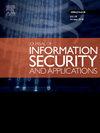SteriCNN:云原生偷窃内容消毒框架
IF 3.8
2区 计算机科学
Q2 COMPUTER SCIENCE, INFORMATION SYSTEMS
Journal of Information Security and Applications
Pub Date : 2024-11-09
DOI:10.1016/j.jisa.2024.103908
引用次数: 0
摘要
由于基于深度学习(DL)的隐写技术近年来取得了长足进步,基于隐写术的现代鲁棒网络攻击往往会绕过固有的云安全措施,而当代的隐写术分析方法很难应对这些隐蔽威胁。现有的隐写术去除方法受制于处理时间长、净化图像质量差以及隐写术内容去除不充分等权衡因素。本文介绍了 SteriCNN,这是一种轻量级的深度残差神经网络模型,专为去除隐写术而设计。SteriCNN 能有效去除嵌入的隐写信息,同时保持净化图像的视觉完整性。我们采用了一系列具有三个残差连接的卷积块来进行特征提取、特征学习、特征关注和残差图像重建。所提出的模型利用通道特征的相关性实现了更快的学习速度,通过改变卷积块的扩张率,该模型实现了更宽的感受野,使其能够在每一层覆盖输入图像的更大区域。由于 SteriCNN 的训练和预测时间成本较低,因此适用于实时使用情况下的盲图像消毒。我们的研究针对传统和基于深度学习的偷窃漏洞都取得了令人印象深刻的结果,在使用流行的偷窃方法进行测试时,约 90% 的偷窃图被消除,同时保持了 46 dB 的平均 PSNR 值和 0.99 的 SSIM 值。本文章由计算机程序翻译,如有差异,请以英文原文为准。
SteriCNN: Cloud native stego content sterilization framework
Modern robust steganography-based cyber attacks often bypass intrinsic cloud security measures, and contemporary steganalysis methods struggle to address these covert threats due to recent advancements in deep learning (DL)-based steganography techniques. Existing steganography removal methods are constrained by trade-offs involving high processing times, poor quality of sanitized images, and insufficient removal of steganographic content. This paper introduces SteriCNN, a lightweight deep residual neural network model designed for steganography removal. SteriCNN effectively eliminates embedded steganographic information while preserving the visual integrity of the sanitized images. We employ a series of convolutional blocks with three residual connections for feature extraction, feature learning, feature attention, and image reconstruction from the residue. The proposed model utilizes the correlation of channel features to achieve a faster learning rate, and by varying the dilation rate in convolutional blocks, the model achieves wider receptive fields, enabling it to cover larger areas of the input image at each layer. SteriCNN is targeted for blind image sterilization for real-time use cases due to its low training and prediction time costs. Our study shows impressive results for both traditional and deep learning-based stego vulnerabilities, with approximately 90% of steganograms eliminated while maintaining an average PSNR value of 46 dB and an SSIM of 0.99 when tested with popular steganography methods.
求助全文
通过发布文献求助,成功后即可免费获取论文全文。
去求助
来源期刊

Journal of Information Security and Applications
Computer Science-Computer Networks and Communications
CiteScore
10.90
自引率
5.40%
发文量
206
审稿时长
56 days
期刊介绍:
Journal of Information Security and Applications (JISA) focuses on the original research and practice-driven applications with relevance to information security and applications. JISA provides a common linkage between a vibrant scientific and research community and industry professionals by offering a clear view on modern problems and challenges in information security, as well as identifying promising scientific and "best-practice" solutions. JISA issues offer a balance between original research work and innovative industrial approaches by internationally renowned information security experts and researchers.
 求助内容:
求助内容: 应助结果提醒方式:
应助结果提醒方式:


